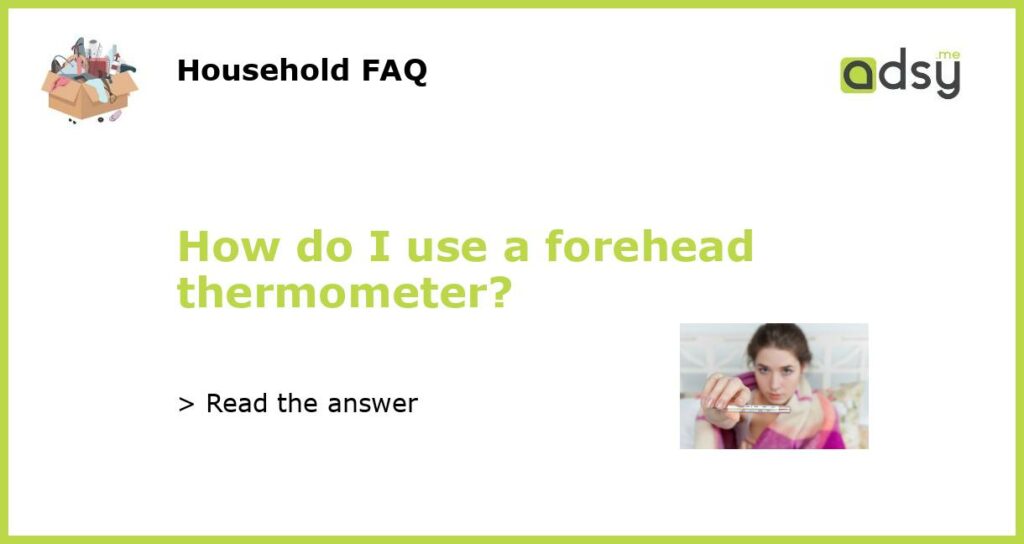Benefits of Using a Forehead Thermometer
A forehead thermometer is a non-contact device that provides an accurate and quick measurement of a person’s body temperature. Compared to traditional methods, such as oral or underarm thermometers, using a forehead thermometer offers several benefits.
Firstly, using a forehead thermometer is non-invasive and hygienic. Unlike oral or underarm thermometers that require contact with the body, a forehead thermometer measures temperature by simply scanning the forehead from a distance of 1-5 centimeters. This makes it suitable for use on children and infants who might be uncomfortable with other measurement methods. Additionally, the non-contact nature of the device eliminates the risk of cross-contamination, making it a safer option in healthcare settings or for multiple users.
How to Use a Forehead Thermometer
Using a forehead thermometer is a simple process that can be done at home or in a healthcare setting. Here are the basic steps to follow:
1. Ensure that the thermometer is clean and ready for use. If necessary, remove the protective cap or cover and check the batteries.
2. Press the power button to turn on the thermometer.
3. Position the thermometer at a distance of 1-5 centimeters from the middle of the forehead.
4. Slowly move the thermometer towards the center of the forehead while keeping it in contact with the skin. Follow the manufacturer’s instructions for specific movement directions.
5. Wait for the thermometer to beep or indicate that the measurement is complete.
6. Read and record the temperature displayed on the thermometer.
7. Clean the thermometer if necessary and store it properly for future use.
Tips for Accurate Readings
To ensure accurate readings when using a forehead thermometer, it is important to follow these tips:
1. Ensure that the forehead is clean and free from sweat, hair, or any obstructions that could affect the measurement. Wipe the forehead if necessary.
2. Avoid taking measurements in extreme temperature conditions, such as after exercising or being exposed to hot or cold environments.
3. Hold the thermometer steady and ensure that it is at the correct distance from the forehead as specified by the manufacturer.
4. Follow the manufacturer’s instructions for any additional requirements, such as waiting for the thermometer to adjust to room temperature before use.
5. Take multiple readings if necessary and compare the results to ensure accuracy. If there are inconsistencies, consult the manufacturer’s guidelines or contact customer support.
6. If using the thermometer on multiple individuals, clean the probe or forehead contact area between each use to prevent cross-contamination.
When to Use a Forehead Thermometer
A forehead thermometer can be used in various situations and for different age groups. It is particularly useful in the following scenarios:
1. Checking the body temperature of infants and children: Since a forehead thermometer is non-contact and quick, it is an excellent option for measuring the temperature of young children who might resist oral or underarm thermometers. It allows for a hassle-free and comfortable experience for both the child and the caregiver.
2. Monitoring temperature in healthcare settings: Forehead thermometers are often used in hospitals, clinics, and other healthcare facilities for quick and accurate temperature measurements. The non-contact feature ensures the safety of both patients and healthcare professionals by minimizing the risk of cross-contamination.
3. Screening individuals at entrances or public places: During times of outbreaks or pandemics, forehead thermometers are used to screen individuals for elevated body temperatures. This helps to identify potentially symptomatic individuals and prevent the spread of infectious diseases.
Pros and Cons of Forehead Thermometers
Like any medical device, forehead thermometers have their advantages and disadvantages. Understanding these can help you decide whether they are suitable for your needs.
Pros:
– Non-contact and hygienic
– Quick measurement
– Suitable for children and infants
– Can be used in healthcare settings
– Ideal for screening individuals in public places
Cons:
– May have limitations in accuracy compared to other measurement methods, such as rectal thermometers
– Can be affected by external factors, such as ambient temperature or sweat on the forehead
– Some forehead thermometers may require specific maintenance or cleaning procedures
– Initial cost may be higher compared to traditional thermometers
Despite the potential limitations, forehead thermometers remain a popular choice for many due to their convenience, safety, and quick results.






